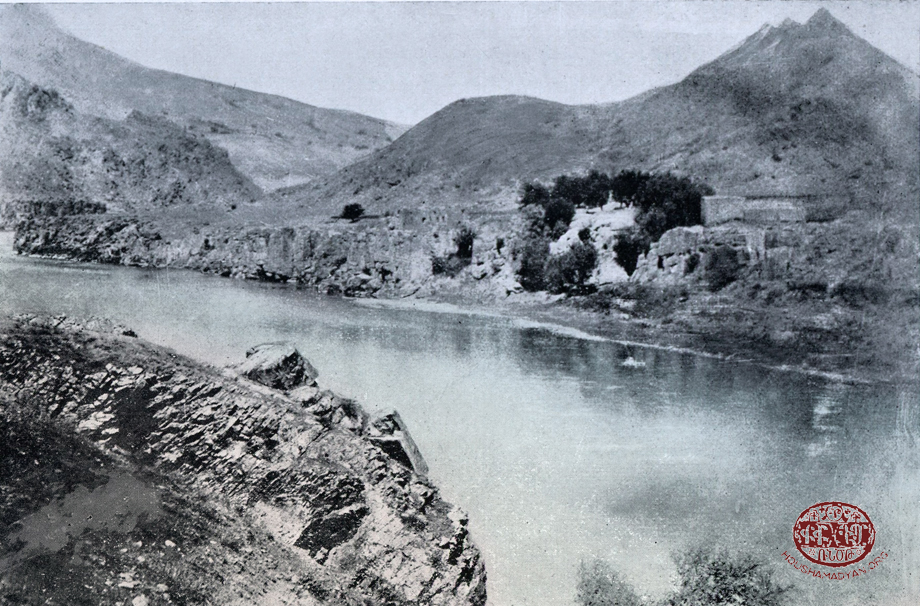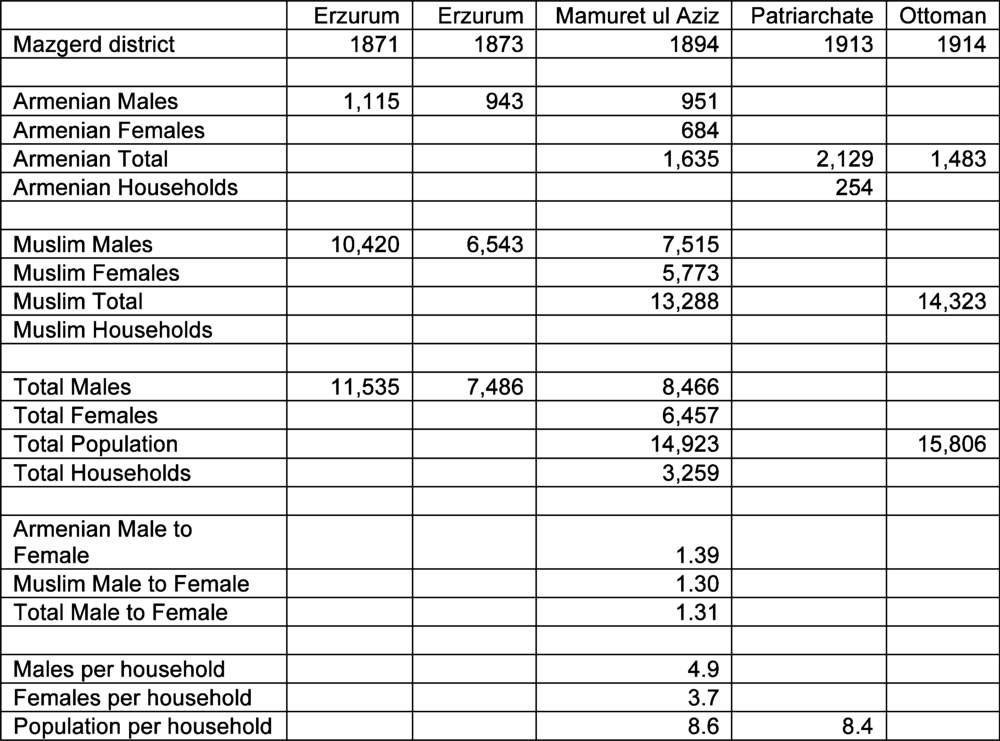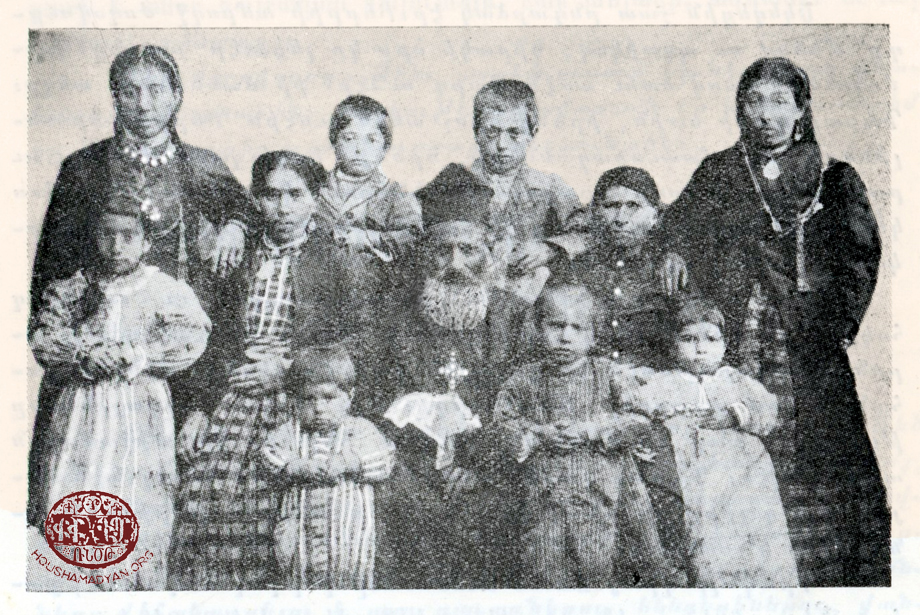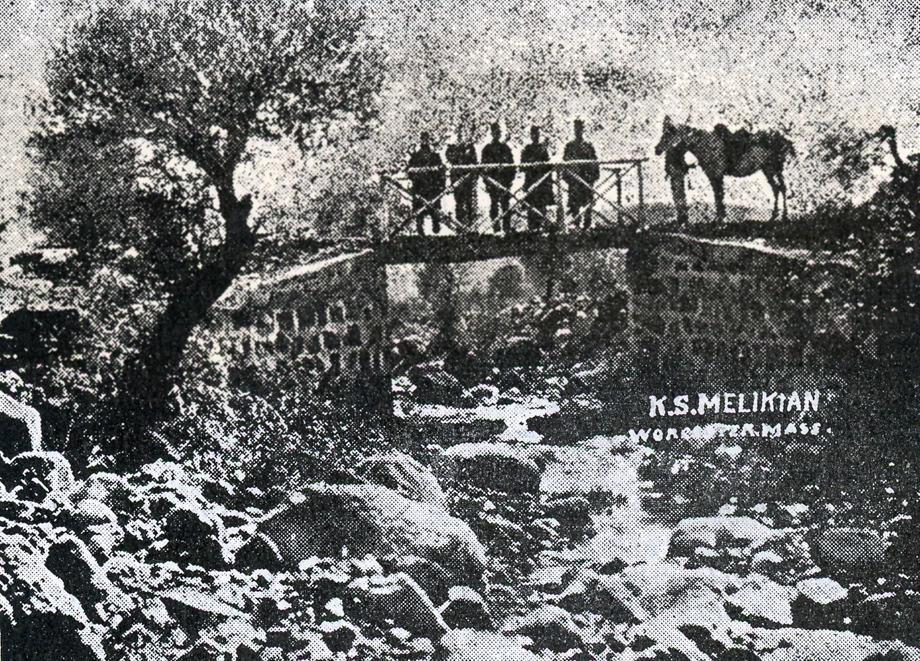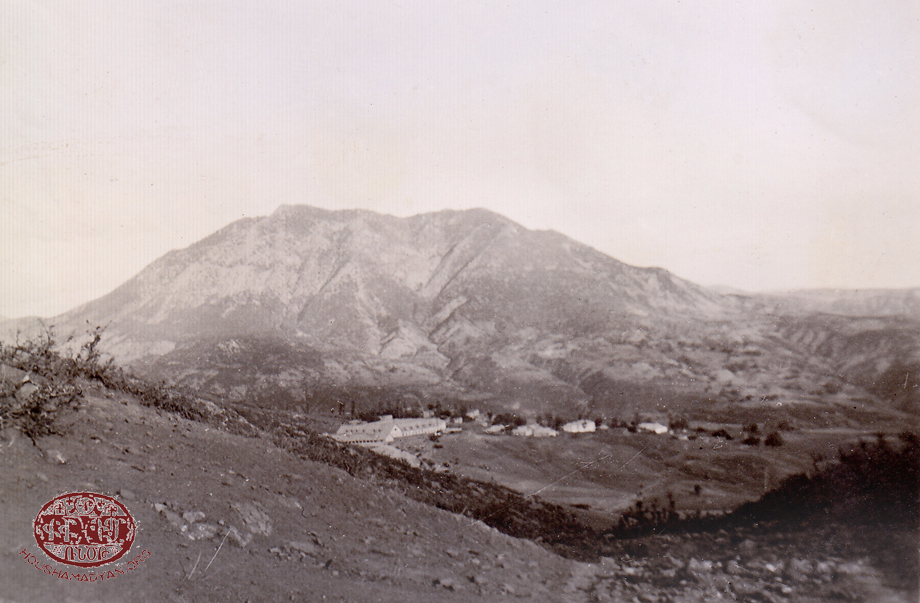Dersim - Demography III
Author: George Aghjayan, 16/07/15 (Last modified: 16/07/15)
Charsandjak district
The Charsandjak district was the southeastern most in the Dersim region, bordering the region of Palu. Over 50 villages in the district contained an Armenian population on the eve of the genocide.
The 1872 [1288 Hidjra] Diyarbekir yearbook [salname] reported 7665 males (3945 Muslim and 3720 non-Muslim) in 2368 households for Charsandjak and surrounding 92 villages of the district that included Pertag.
The 1875 [1292 Hidjra] Diyarbekir yearbook reported 1246 males (234 Muslim and 1012 non-Muslim) in 401 households for Peri, the chief town of Charsandjak. For the town of Pertag, 1297 males (1117 Muslim and 180 non-Muslim) in 530 households were reported. These same population figures were reported in the yearbook for the following year with only slight differences – the non-Muslim male population for Charsandjak was increased by 100 and the number of households for Pertag was reduced by 10. It appears these were corrections and not newly introduced errors.
By 1881 [1298 Hidjra], Charsandjak had become part of the recently created Mamuretul Aziz province and the yearbook that year reported the following data:
4 neighborhoods of Peri town
1336 total males (350 Muslim, 986 Armenian Apostolic) in 401 households
73 villages of Charsandjak district
3925 total males (1271 Muslim, 2654 Armenian Apostolic) in 1381 households
6 neighborhoods of Pertag town
1154 total males (966 Muslim, 188 Armenian Apostolic) in 520 households
23 villages of Pertag district
1127 total males (943 Muslim, 184 Armenian Apostolic) in 552 households
The following are summary tables for the districts of Charsandjak and Pertag.
A similar analysis to that of Chmshgadzak yields slightly different results for the combined Pertag/Charsandjak region. The chief towns of Peri and Pertag, while of similar size, were mirror images in regards to the religious composition of the population. Peri was 79% Christian, while Pertag was 84% Muslim. For these two towns, the population per household exhibited similar trends as with Chmshgadzak. Specifically, Armenian Peri had a higher population per household (6.1) versus Muslim Pertag (4.9). However, of the 106 villages in the district, only 4 contained an entirely Armenian population. Due to the small number of Armenian-only villages, a population per household (4.6) is not as meaningful, although it was higher than for the Muslim only villages (4.3). Unlike Chmshgadzak, the villages containing a mixed population had the highest population per household of 5.4. In addition, there was no discernable trend in household population by the size of the village. The undercounting of women appears to have been more extensive in the Charsandjak district (including Pertag). The recorded number of males exceeded females by 538 for Muslims and 473 for non-Muslims. By 1914, Ottoman records reported the Muslim population of the Charsandjak district had grown from 8216 to 12157 while the non-Muslim population had increased from 6723 to 7105. The 1914 census of the Armenian Patriarchate recorded 7931 Armenians in 1145 households.
1. Peri, Charsandjak, Perri, Perin [Akpazar]
38°50'59.40"N 39°40'43.51"E
1763 Armenians in 310 households
Sp. Asdvadzadzin church
Garmir vank
Srvantsdiants states the town had 318 Armenian households. Around the same time as Srvantsdiants, Rev. Boghos Natanian carried out a census of various regions and stated Peri had 3200 Armenians in 400 households (clearly he used a simple factor of 8 people per household). The 1894 Mamuretul Aziz yearbook stated there were 2043 Armenian Apostolics (1061 males and 982 females), 71 Protestants (31 males and 40 females) and 564 Muslims (302 males and 262 females) living in 442 total households in Peri. In 1914, the Armenian Patriarchate recorded the population declining to 1763 Armenians in 310 households.
2. Aghmezre, Akmezre
38°52'5.85"N 39°28'45.58"E
21 households
Sp. Karasoun Mangounk church
The location of Aghmezre is based on old maps although it could have been slightly east of the coordinates given. There does not appear to be any settlement there today. Srvantsdiants states the village had 30 Armenian households while Natanian offers 20. The 1894 Mamuretul Aziz yearbook stated there were 66 Armenians (33 males and 33 females) and 42 Muslims (21 males and 21 females) living in 29 total households. In 1914, the Armenian Patriarchate recorded the Armenian households numbered 21 without stating the population.
1) Peri, ca 1912. (From left): Khatoun Topdjian Poochigian (1897-1987); Koharig Garabedian Poochigian (1873-1914); Manoug Hagop Poochigian (1893-1912); Aznive Poochigian Tashjian (1898-1977) (Source: Mary Jane Kahaian Poochigian collection)
2) Peri: Ermoyan family, October 15, 1898. We only know the father (Haroutiun Ermoyan, seated wearing fez) and his son Hrant standing to the right. All family members were killed in 1915 (Source: Kevork S. Yerevanian, History of Charsandjak Armenians [in Armenian], Beirut, 1956)
3. Ayvatlu, Hayvatli, Ayvarlou [Ayvatlı]
38°54'31.18"N 39°47'44.78"E
72 Armenians in 11 households
Sp. Minas church
Srvantsdiants states the village had 9 Armenian households while Natanian offers 10. The 1894 Mamuretul Aziz yearbook stated there were 64 Armenians (36 males and 28 females) and 54 Muslims (31 males and 23 females) living in 21 total households. In 1914, the Armenian Patriarchate recorded 72 Armenians in 11 households.
Poochigian family, Peri, circa 1895. From left – Kevork Poochigian (standing), Kevork Poochigian (family grandfather, seated), Bagdasar Poochigian (in Kevork’s lap), Bedros Poochigian (family father, seated), Beniam Poochigian (seated in father’s lap). Last row, standing – Khandil Poochigian (nee Holopigian), wife of Bedros. Front row – Jessica Poochigian (seated on stool) (Source: Minnie Poochigian Caton collection)
4. Balusher, Balashehr, Balasher [Beydamı]
38°57'6.49"N 39°27'59.71"E
166 Armenians in 20 households
Sp. Sarkis church, Sp. Toros church, Sp. Krikor church, Sp. Prgich church
Khrandili Vank
Both Srvantsdiants and Natanian state the town had 30 Armenian households. The 1894 Mamuretul Aziz yearbook stated there were 96 Armenians (53 males and 43 females) and 37 Muslims (22 males and 15 females) living in 28 total households. In 1914, the Armenian Patriarchate recorded 166 Armenians in 20 households.
5. Basou, Baso, Pasou, Bassou [Güneşdere]
38°53'16.41"N 39°41'1.92"E
240 Armenians in 30 households
Sp. Krikor Lousavorich church
Both Srvantsdiants Natanian state the town had 25 Armenian households. The 1894 Mamuretul Aziz yearbook stated there were 240 Armenians (115 males and 125 females) and 5 Muslims (3 males and 2 females) living in 28 total households. In 1914, the Armenian Patriarchate recorded 240 Armenians in 30 households.
6. Deng, Denk
38°50'34.63"N 39°44'20.16"E
no Armenians in 1914
no church
The village of Deng was included in the 1840 [1256 hidjra] Ottoman census for the Palu district. It recorded only males, 25 Armenians in 8 households. Both Srvantsdiants and Natanian state the village had 3 Armenian households. The 1894 Mamuretul Aziz yearbook stated there were 4 Armenians (3 males and 1 female) and 68 Muslims (33 males and 35 females) living in 14 total households. By 1915, the long decline had been completed, there were no longer any Armenians reported as living in the village.
7. Gadosan, Kadosa [Karagüney]
38°53'21.50"N 39°34'38.45"E
no Armenians in 1914
Sp. Garabed church
Srvantsdiants supplies a name of Sp. Asdvadzadzin for the church, but other sources consistently refer to it as Sp. Garabed. Srvantsdiants states the village had 17 Armenian households while Natanian offers 20. The 1894 Mamuretul Aziz yearbook stated there were 58 Armenians (33 males and 25 females) and 22 Muslims (11 males and 11 females) living in 19 total households. The Patriarchate did not report any Armenians in the village in 1914. Although, Yerevanian and Haladjian both state the village had 15 Armenian households.
8. Geok Tepe [Göktepe]
38°55'48.74"N 39°36'48.42"E
200 Armenians in 25 households
Sp. Garabed church
Srvantsdiants states the village had 40 Armenian households while Natanian offers 38. The 1894 Mamuretul Aziz yearbook stated there were 205 Armenians (114 males and 91 females) and 68 Muslims (37 males and 31 females) living in 48 total households. In 1914, the Armenian Patriarchate recorded 200 Armenians in 25 households.
9. Ghayazin, Ghayachin, Khayachi, Khayazi [Kayacı]
38°53'24.08"N 39°48'6.85"E
88 Armenians in 8 households
Sp. Minas church
Srvantsdiants states the village had 10 Armenian households while Natanian offers 15. The 1894 Mamuretul Aziz yearbook stated there were 131 Armenians (71 males and 60 females) and 27 Muslims (14 males and 13 females) living in 26 total households. In 1914, the Armenian Patriarchate reported the population had declined to 88 Armenians in 8 households.
10. Gorjan, Korjan
38°55'4.60"N 39°37'6.92"E
130 Armenians in 24 households
Sp. Asdvadzadzin church
While in 1935, the village had a population of 39, by 1940 it was empty or no longer listed as a separate village. Srvantsdiants states the village had 12 Armenian households while Natanian offers 15. The 1894 Mamuretul Aziz yearbook stated there were 83 Armenians (39 males and 44 females) and 40 Muslims (20 males and 20 females) living in 22 total households. In 1914, the Armenian Patriarchate reported the population had increased to 130 Armenians in 24 households.
11. Havseg Varin, Vari avseg [Aşağı Havzik]
38°55'54.54"N 39°35'25.24"E
125 Armenians in 15 households
Sp. Andon church
Srvantsdiants states the village only had 15 Armenian households while Natanian offers 25. The 1894 Mamuretul Aziz yearbook stated there were 81 Armenians (47 males and 34 females) and 20 Muslims (12 males and 8 females) living in 28 total households. In 1914, the Armenian Patriarchate reported the population as 125 Armenians in 15 households.
12. Havseg Verin, Veri avseg, Yukarı Havzik [Böğürtlen]
38°56'44.56"N 39°34'56.40"E
61 Armenians in 7 households
Sp. Minas church (Srvantsdiants states the name as Sp. Asdvadzadzin)
Srvantsdiants states the village only had 14 Armenian households while Natanian offers 20. The 1894 Mamuretul Aziz yearbook stated there were 105 Armenians (60 males and 45 females) and 24 Muslims (15 males and 9 females) living in 22 total households. In 1914, the Armenian Patriarchate reported the population as declining to 61 Armenians in 7 households.
13. Havshakar, Havlapar, Avshakar, Houshakar [Akdemir]
38°59'10.06"N 39° 8'59.27"E
260 Armenians 40 households
Sp. Kevork church, Sp. Sarkis church
There is some confusion over the number and name of churches in the village. Teotig lists only one church named Sp. Hovhannes while Yerevanian, Eprigian and Srvantsdiants only list the Sp. Kevork church. Kévorkian and Safrastyan state there were two churches in the village named Sp. Kevork and Sp. Sarkis. Karekin Srvantsdiants indicates the village had 38 Armenians households, while Natanian only offers 15 households. H. S. Eprigian also states 38 Armenian households, most likely taken from Srvantsdiants. The 1894 Mamuretul Aziz yearbook stated there were 115 Armenians (61 males and 54 females) and 8 Muslims (3 males and 5 females) living in 35 total households in Havshakar. In 1914, the Armenian Patriarchate recorded the population remained stable with 260 Armenians in 40 households.
14. Hoshe [Karşıkonak]
38°50'31.09"N 39°41'35.09"E
238 Armenians in 29 households
Sp. Asdvadzadzin church
Sp. Boghos vank
The 1840 Ottoman census for Palu included Hoshe with a population of 110 Armenian males in 28 households. Srvantsdiants states the village had 25 Armenian households while Natanian offers 20. The 1894 Mamuretul Aziz yearbook indicates the village was entirely Armenian with a population of 118 Armenians (71 males and 47 females) in 21 total households. Consistent with other villages, the women were clearly undercounted. In 1914, the Armenian Patriarchate reported the population had grown to 238 Armenians in 29 households.
15. Ismayeltsik [Ismailli]
38°53'30.49"N 39°37'24.01"E
312 Armenians in 38 households
Sp. Asdvadzadzin church
Sp. Loys/Lousavorich vank
Srvantsdiants states the village only had 25 Armenian households while Natanian offers 40 households. The 1894 Mamuretul Aziz yearbook stated there were 238 Armenians (138 males and 100 females) and 84 Muslims (41 males and 43 females) living in 51 total households. In 1914, the Armenian Patriarchate reported the population as 312 Armenians in 38 households.
16. Kaladjuk, Kaladjek
38°53'44.53"N 39°27'20.27"E
56 Armenians in 6 households
no church
This small Armenian village is most likely a hamlet of Yeniköy today. Srvantsdiants states the village only had 4 Armenian households while Natanian does not mention the village at all. The 1894 Mamuretul Aziz yearbook stated there were 15 Armenians (9 males and 6 females) living in 4 households. In 1914, the Armenian Patriarchate reported the population had grown to 56 Armenians in 6 households.
17. Karapounar, Gharapounar
38°56'17.31"N 39°33'9.68"E
no Armenians in 1914
no church
Both Srvantsdiants and Natanian state the village had 8 Armenian households. The 1894 Mamuretul Aziz yearbook stated there were 40 Armenians (18 males and 22 females) and 27 Muslims (13 males and 14 females) living in 12 total households. In 1914, the Armenian Patriarchate did not report an Armenian population in the village although Yerevanian indicates there were 17 Armenian households which seems unlikely.
18. Khadjar Varin, Khadjar Sufla, Yukari Ashaghi [Aşağı Kacarlar]
38°56'26.02"N 39°31'34.61"E
71 Armenians in 7 households
1 church in ruins
Srvantsdiants states the village had 4 Armenian households while Natanian offers 8. The 1894 Mamuretul Aziz yearbook stated there were 13 Armenians (8 males and 5 females) and 3 Muslims (2 males and 1 female) living in 4 total households. In 1914, the Armenian Patriarchate reported the population had grown to 71 Armenians in 7 households.
19. Khajar Verin, Khajar Ulya, Khajar Yukari [Yukarı Kacarlar]
38°56'27.89"N 39°30'32.18"E
46 Armenians in 6 households
1 church in ruins
Srvantsdiants states the village had 6 Armenian households while Natanian offers 10. The 1894 Mamuretul Aziz yearbook stated there were 29 Armenians (17 males and 12 females) and 5 Muslims (2 males and 3 females) living in 8 total households. In 1914, the Armenian Patriarchate reported the population had grown to 46 Armenians in 6 households.
20. Kharesig, Kharessig, Gharesig, Havashik, Harasenk [Biçmekaya]
38°51'15.13"N 39°29'36.66"E
112 Armenians in 12 households
Sp. Asdvadzadzin church
Sp. Garabed vank
Srvantsdiants and Teotig identify the church as Sp. Garabed while Kévorkian and Yerevanian state it is Sp. Asdvadzadzin. Safrastyan states the church is Sp. Asdadzadzin while a monastery nearby was called Sp. Garabed. Srvantsdiants states the village had 22 Armenian households while Natanian offers 25. The 1894 Mamuretul Aziz yearbook stated there were 108 Armenians (61 males and 47 females) and 46 Muslims (26 males and 20 females) living in 35 total households. In 1914, the Armenian Patriarchate reported the population had declined to 112 Armenians in 12 households.
21. Khrneg, Khmig, Khurnig [Hırnik]
38°54'49.92"N 39°33'41.76"E
74 Armenians in 13 households
Sp. Hagop church
Srvantsdiants states the village had 15 Armenian households while Natanian offers 25. The 1894 Mamuretul Aziz yearbook stated there were 62 Armenians (40 males and 22 females) and 16 Muslims (8 males and 8 females) living in 16 total households. In 1914, the Armenian Patriarchate reported the population as 74 Armenians in 13 households.
22. Kodaridj, Kodarich, Godarich, Kurdaridj, Koderich [Güneyharman]
38°54'33.31"N 39°44'55.70"E
300 Armenians in 33 households
Sp. Kevork church
Srvantsdiants states the village had 27 Armenian households while Natanian offers 30. The 1894 Mamuretul Aziz yearbook stated there were 127 Armenians (62 males and 65 females) and 54 Muslims (31 males and 23 females) living in 37 total households. In 1914, the Armenian Patriarchate reported the population had grown to 300 Armenians in 33 households.
23. Kourekan, Kiureken [Obuzbaşı]
38°52'57.03"N 39°49'34.46"E
no Armenians in 1914
no church
Both Yerevanian and Antranig indicate an entirely Armenian population in Kourekan of 20 households. However, the 1894 Mamuretul Aziz yearbook stated there were 104 Armenians (50 males and 54 females) and 28 Muslims (15 males and 13 females) living in 20 total households. No other Armenian sources mention the village. I presume Antranig as the source for the information in Yerevanian. The data could be interpreted as evidence of an Armenian village gradually converting to Islam or it could be that Armenians moved away as Muslims moved into the village.
24. Koushin, Khoushdji, Koushdji [Kuşçu]
38°51'56.76"N 39°43'32.20"E
177 Armenians in 25 households
Sp. Asdvadzadzin church
Sp. Andon vank
Srvantsdiants states the village had 20 Armenian households while Natanian offers 24. The 1894 Mamuretul Aziz yearbook stated there were 153 Armenians (85 males and 68 females) and 28 Muslims (18 males and 10 females) living in 27 total households. In 1914, the Armenian Patriarchate reported the population at 177 Armenians in 25 households.
25. Koushin Mezre, Khoushdji Mezre, Koushdji Mezre [Kuşçu Mezrası]
38°52'48.03"N 39°44'3.06"E
61 Armenians in 5 households
Sp. Garabed church
Both Srvantsdiants and Natanian state the village had 6 Armenian households. The 1894 Mamuretul Aziz yearbook stated the village was entirely Armenian with a population of 52 (27 males and 25 females) living in 9 total households. In 1914, the Armenian Patriarchate reported the population at 61 Armenians in 5 households.
26. Kouzouldjouk, Ghuzuldjoukh, Ghuzuldjough, Kyzildjoukh [Kızılcık]
38°54'5.71"N 39°38'45.02"E
232 Armenians in 15 households
Sp. Asdvadzadzin or Asdvadzamayr church
Both Srvantsdiants and Natanian state the village had 20 Armenian households. In 1914, the Armenian Patriarchate reported the population at 232 Armenians in 15 households. The 1894 Mamuretul Aziz yearbook does not list the village. However, one of the neighborhoods of the town of Peri is referred to as Kuzujuk. While Kouzouljouk is too far from Peri to be considered a neighborhood, it could be a misspelling as well as a misidentification in the yearbook. The recorded population for this neighborhood would seem to be consistent with that of Kouzouljouk, 134 Armenians (63 males and 71 females) and 3 Muslims (1 male and 2 females) in 19 total households.
27. Lousadarich, Mousadarich [Arpalı]
38°54'59.09"N 39°31'38.30"E
Lousadarich Mezre
38°54'39.45"N 39°31'46.94"E
174 Armenians in 19 households
Sp. Hagop church
Sp. Yerek Mangounk or Yerits Mangants vank (Kévorkian and Teotig state the name as Sp. Karasoun Mangounk vank)
Natanian is the only source that splits the villages with a total of 25 Armenian households (15 in Lousadarich and 10 in Lousadarich Mezre). All other sources do not list Lousadarich Mezre as a separate village. Srvantsdiants states the village had 24 Armenian households. The 1894 Mamuretul Aziz yearbook states a population of 143 Armenians (81 males and 62 females) and 33 Muslims (17 males and 16 females) living in 30 total households. In 1914, the Armenian Patriarchate reported the population at 174 Armenians in 19 households.
28. Margig, Margeg, Margik, Mergeg [Günboğazı]
38°57'39.43"N 39°26'28.51"E
20 Armenians in 4 households
no church
Srvantsdiants states the village had 12 Armenian households while Natanian offers 20. The 1894 Mamuretul Aziz yearbook stated there were 38 Armenians (19 males and 19 females) and 32 Muslims (21 males and 11 females) living in 11 total households. In 1914, the Armenian Patriarchate reported the population had further declined to 20 Armenians in 4 households.
29. Merdjoumeg, Merdjimeg [Mercimek]
38°51'43.10"N 39°23'27.63"E
no Armenians in 1914
Sp. Hagop church (Yerevanian states the name as Sp. Hovhannes church)
Srvantsdiants states the village had 9 Armenian households while Natanian offers 10. The 1894 Mamuretul Aziz yearbook stated there were 28 Armenians (16 males and 12 females) and 105 Muslims (66 males and 39 females) living in 23 total households. In 1914, the Armenian Patriarchate did not report any Armenians living in the village.
30. Nor Kiugh [Yeniköy]
38°53'51.94"N 39°26'35.60"E
122 Armenians in 35 households
Sp. Kevork church
Srvantsdiants states the village had 12 Armenian households while Natanian offers the unreasonably high figure of 40. The 1894 Mamuretul Aziz yearbook stated there were 53 Armenians (36 males and 17 females) and 5 Muslims (1 male and 4 females) living in 19 total households. In 1914, the Armenian Patriarchate reported the village had grown to 122 Armenians in 35 households.
31. Oureg Verin [Yukari Yakabaşi]
38°50'48.65"N 39°28'11.14"E
122 Armenians in 15 households
Sp. Hovhannes church
Srvantsdiants states the village had 10 Armenian households while Natanian offers 12. The 1894 Mamuretul Aziz yearbook stated there were 53 Armenians (32 males and 21 females) and 40 Muslims (20 males and 20 females) living in 11 total households. The number of households seems unreasonably low. In 1914, the Armenian Patriarchate reported the village had grown to 122 Armenians in 15 households.
32. Ourts, Khors, Hurs, Huris [Örsköy]
38°54'30.70"N 39°43'30.91"E
195 Armenians in 22 households
Sp. Minas church
Srvantsdiants states the village had 21 Armenian households while Natanian offers 25. The 1894 Mamuretul Aziz yearbook stated there were 149 Armenians (85 males and 64 females) and 103 Muslims (52 males and 51 females) living in 36 total households. In 1914, the Armenian Patriarchate reported the population at 195 Armenians in 22 households.
33. Paghnik, Paghnig [Kepektaş]
38°51'31.64"N 39°42'39.19"E
93 Armenians in 12 households
Sp. Minas church
Srvantsdiants states the village had 13 Armenian households while Natanian offers 12. The 1894 Mamuretul Aziz yearbook stated there were 77 Armenians (42 males and 35 females) and 38 Muslims (20 males and 18 females) living in 19 total households. In 1914, the Armenian Patriarchate reported the population at 93 Armenians in 12 households.
34. Pashavank, Pashaghag, Bashaghag [Pınarlar]
38°52'33.65"N 39°28'39.71"E
Pashavank Mezra
38°52'23.28"N 39°28'22.85"E
632 Armenians in 96 households
Sp. Sarkis church
Sp. Hovhannes vank (Yerevanian) or Sp. Karasoun Mangounk vank (Kévorkian)
Only the 1914 Armenian Patriarchate census listed the villages separately. Srvantsdiants states the village had 89 Armenian households while Natanian offers 70. The 1894 Mamuretul Aziz yearbook stated there were 259 Armenians (137 males and 122 females) and 82 Muslims (45 males and 37 females) living in 81 total households. In 1914, the Armenian Patriarchate reported the population at 497 Armenians in 75 households for Pashavank and 135 Armenians in 21 households for Pashavank Mezra.
35. Pertag [Pertek]
38°52'1.83"N 39°19'27.74"E
445 Armenians 45 households
Sp. Toros church, Sp. Asdvadzadzin church, Sp. Shmavon church
Sp. Karasoun Mangounk Vank
Both Srvantsdiants and Natanian state the village had 60 Armenian households. The 1894 Mamuretul Aziz yearbook stated there were 408 Armenians (210 males and 198 females) and 2088 Muslims (1082 males and 1006 females) living in 512 total households. In 1914, the Armenian Patriarchate reported the population at 265 Armenians in 45 households. Another 180 Armenians were reported to still be living in Eski Pertag or old Pertag, the location prior to the move due to the rising water levels of the Eastern Euphrates River. The total population is given even though no household count was supplied for the Armenians of Eski Pertag.
36. Pertagi Til [Korluca]
38°49'48.50"N 39°19'12.68"E
108 Armenians in 27 households
Sp. Sarkis church
Srvantsdiants states the village had 40 Armenian households while Natanian offers 35. The 1894 Mamuretul Aziz yearbook states the village was entirely Armenian with a population of 206 (105 males and 101 females) in 51 households. In 1914, the Armenian Patriarchate reported the population had declined to 108 Armenians in 27 households. There were a number of villages with Til in the name variously referred to in the sources – Til, Til Verin, Pokr Til, Pertag Til. I believe these to all be references to one of two villages, Pertagi Til and the village Til just east of the town of Peri (see #45). Teotig erroneously makes reference to 3 villages, but I believe the reference to Til and Verin Til are a duplication.
37. Saghman, Tsaghman [Sağman]
38°55'11.96"N 39°17'54.56"E
30 Armenians
Sp. Kevork church (Srvantsdiants and Teotig) or Sp. Sarkis church (Yerevanian and Kévorkian)
The current town of Saghman is north of the old town which was much closer to the fortress. Srvantsdiants states the village had 4 Armenian households while Natanian offers 10. The 1894 Mamuretul Aziz yearbook stated there were 10 Armenians (5 males and 5 females) and 526 Muslims (273 males and 253 females) living in 95 total households. In 1914, the Armenian Patriarchate reported only the population as 30 Armenians without specifying the number of households.
38. Sevdjogh, Svdjogh, Soghdjov, Sevdjoukh, Sghdjov, Shihso [Burmageçit]
38°57'56.76"N 39°32'21.94"E
333 Armenians in 53 households
Sp. Hagop church, Sp. Sarkis church
3 monasteries in ruins
All sources consistently name the Sp. Hagop church. Safrastyan states the names of other churches as Sp. Yerits Mangants and Sp. Varvar while Kévorkian names Sp. Sarkis. Srvantsdiants states the village had 36 Armenian households while Natanian offers 30. The 1894 Mamuretul Aziz yearbook stated there were 307 Armenians (162 males and 145 females) and 86 Muslims (42 males and 44 females) living in 55 total households. In 1914, the Armenian Patriarchate reported the population as 333 Armenians in 53 households.
39. Seyidli, Seyitli [Elmalık]
38°52'21.72"N 39°47'3.72"E
no Armenians in 1914
no church
Both Srvantsdiants and Natanian state the village had 4 Armenian households. However, thereafter no Armenians are reported to have lived in the village. The 1894 Mamuretul Aziz yearbook states the village was entirely Muslim with a population of 65 people (30 males and 35 females) living in 16 total households.
40. Shamtsik, Shamli, Shentsik, Shantsik [Çimenli]
38°54'26.15"N 39°35'42.27"E
31 Armenians in 2 households
1 church in ruins
Srvantsdiants states the village had 8 Armenian households while Natanian offers 10. The 1894 Mamuretul Aziz yearbook stated there were 52 Armenians (25 males and 27 females) and 11 Muslims (6 males and 5 females) living in 12 total households. In 1914, the Armenian Patriarchate reported the population declined to 31 Armenians in 2 households although the household count seems suspect.
41. Shohmin, Shohmi [Gelinpınar]
38°54'46.64"N 39°42'12.43"E
no Armenians in 1914
no church
Srvantsdiants states the village had 4 Armenian households while Natanian offers 2. The 1894 Mamuretul Aziz yearbook stated there were 8 Armenians (6 males and 2 females) and 117 Muslims (59 males and 58 females) living in 18 total households. Thereafter no Armenians were recorded to have lived there.
42. Sorpian, Sorpiyan [Yolkonak]
38°58'49.68"N 39°28'58.43"E
181 Armenians in 24 households
Sp. Kevork church (Srvantsdiants states the name as Sp. Asdvadzadzin church)
Srvantsdiants states the village had 22 Armenian households while Natanian offers only 8. The 1894 Mamuretul Aziz yearbook stated there were 107 Armenians (71 males and 36 females) and 45 Muslims (23 males and 22 females) living in 27 total households. In 1914, the Armenian Patriarchate reported the population had grown to 181 Armenians in 24 households.
43. Sumakh, Smakh, Sumagh, Smagh [Sumak]
38°53'12.49"N 39°31'5.07"E
no Armenians in 1914
Sp. Kevork church
Srvantsdiants states the village had 10 Armenian households while Natanian offers 18. The 1894 Mamuretul Aziz yearbook stated there were 25 Armenians (16 males and 9 females) and 27 Muslims (15 males and 12 females) living in 12 total households. The 1914 Armenian Patriarchate census does not record any Armenians living in the village, but Haladjian (15 households) and Yerevanian (12 households) contradict this claim.
44. Tants, Tanz, Tantz, Tandz [Tozkoparan]
38°55'42.02"N 39°26'19.17"E
282 Armenians in 32 households
Sp. Sarkis church
Srvantsdiants states the village had 24 Armenian households while Natanian offers 25. The 1894 Mamuretul Aziz yearbook stated there were 32 Armenians (19 males and 13 females) and 23 Muslims (15 males and 8 females) living in 21 total households. In 1914, the Armenian Patriarchate reported the population had grown to 282 Armenians in 32 households. Clearly, there is a significant difference between Armenian and Ottoman sources for this village. Currently, there is no information to explain this discrepancy.
45. Til, Til Verin, Til Ulya, Pokr Til
38°52'2.11"N 39°45'2.59"E
60 Armenians in 5 households
Sp. Sarkis church
Both Srvantsdiants and Natanian state the village had 8 Armenian households. The 1894 Mamuretul Aziz yearbook stated there were 57 Armenians (28 males and 29 females) and 68 Muslims (40 males and 28 females) living in 31 total households. In 1914, the Armenian Patriarchate reported the population as 60 Armenians in 5 households.
46. Tsorag, Soreg, Surek, Sorek [Karabulut]
38°54'26.04"N 39°45'57.31"E
130 Armenians in 17 households
Sp. Garabed church, Sp. Varvar church, Sp. Asdvadzadzin church
1 monastery in ruins
Srvantsdiants states the village had 13 Armenian households while Natanian offers 15. The 1894 Mamuretul Aziz yearbook stated there were 77 Armenians (41 males and 36 females) and 50 Muslims (26 males and 24 females) living in 29 total households. In 1914, the Armenian Patriarchate reported the population as 130 Armenians in 17 households.
47. Vasgerd, Vazgird [Çalıözü]
38°51'46.10"N 39°32'46.99"E
102 Armenians in 20 households
Sp. Toros church, Mayr Mariam church, Sp. Karasoun Mangounk church
Srvantsdiants states the village had 35 Armenian households while Natanian offers 50. The 1894 Mamuretul Aziz yearbook stated there were 211 Armenians (122 males and 89 females) and 53 Muslims (29 males and 24 females) living in 45 total households. In 1914, the Armenian Patriarchate reported the population declining to 102 Armenians in 20 households.
48. Vayna, Vahnay, Vahney, Wahne [neighborhood of Sağman]
38°56'13.41"N 39°16'16.32"E
40 Armenians in 5 households
Sp. Kevork church
Vayna is a neighborhood of the new town of Sağman. Srvantsdiants states the village had 8 Armenian households while Natanian does not mention the village. The 1894 Mamuretul Aziz yearbook stated there were 12 Armenians (2 males and 10 females) and 23 Muslims (13 males and 10 females) living in 13 total households. In 1914, the Armenian Patriarchate reported the population as 40 Armenians in 5 households.
49. Zeri, Ziri, Zerin [Şavkın]
38°50'41.43"N 39°37'22.69"E
22 Armenians in 4 households
no church
It appears the Armenians arrived in Zeri late as only the 1914 Armenian Patriarchate census makes reference to the village. There were 22 Armenians in 4 households recorded. In 1894, the village was entirely Muslim with a population of 91 people (51 males and 40 females) in 17 households.
Mazgerd district
The boundaries of the Mazgerd district appear to have been rather fluid. The 1871 yearbook for the Erzurum province includes 195 villages in the district with a population of 11535 males (10420 Muslim and 1115 Christian). Ottoman sources recorded Armenians as the only Christians in the district, thus the 1115 males should be considered Armenian. It was also noted that there were six Armenian churches. The yearbook for the following year, 1872, reported essentially the same figures. However, the 1873 yearbook stated the population had reduced to 7486 males (6543 Muslim and 943 Christian) in 3088 households. This equates to 2.4 males per household. The number of villages was reported as 499 which is dramatically different from the two earlier yearbooks.
The 1894 Mamuretul Aziz yearbook included 275 villages in the Mazgerd district and another 125 in Kizilkilise for a total of 400 villages. However, the population was not detailed for over 70 of these villages indicating they were remote and nomadic.
The yearbook indicates 22 villages with an Armenian population. The recorded population was 1635 Armenians (951 males and 684 females) and 13288 Muslims (7515 males and 5773 females) in 3259 households. This equates to an average of 2.6 males and 4.6 total population per household. The male to female ratio was 1.30 for Muslims and 1.39 for Armenians. Only two of the villages were indicated to be exclusively Armenian.
The next available sources that identify Mazgerd distinctly are the Armenian Patriarchate data from 1913/14 and an Ottoman summary dated 1914. The Armenian Patriarchate census stated 2129 Armenians living in 254 households on the eve of the genocide in the 12 villages. The Ottoman document states an Armenian population of 1483. Neither source supplies any more detail.
The following table summarizes the data presented above for the Khozat district:
1. Mazgerd, Medzgerd [Mazgirt]
39° 1'14.18"N 39°36'21.19"E
1200 Armenians in 150 households
Sp. Asdvadzadzin church, Sp. Hagop church
7 monasteries in ruins
Srvantsdiants states the village had 80 Armenian households while Natanian offers 70. The 1894 Mamuretul Aziz yearbook stated there were 628 Armenians (339 males and 289 females) and 295 Muslims (147 males and 148 females) living in 140 total households. In 1914, the Armenian Patriarchate reported the population growing to 1200 Armenians in 150 households.
2. Anbar [Ambar]
39° 5'7.77"N 39°38'34.23"E
no Armenians in 1914
no church
Only the 1894 Mamuretul Aziz yearbook records an Armenian population in Anbar. The population was stated to be 10 Armenians (5 males and 5 females) and 34 Muslims (16 males and 18 females) living in 8 total households.
3. Baghin
39° 0'14.34"N 39°53'55.98"E
no Armenians in 1914
no church
Yerevanian and Antranig indicate between 8 and 10 Armenian households. The 1894 Mamuretul Aziz yearbook indicated the village was entirely Muslim (77 people in 14 households). In 1914, the Armenian Patriarchate did not record an Armenian population. The villages of Baghin, Karntsor, Kardere, Isnis and Janig were located in close proximity with each other. Each was known to have an Armenian population at one time, yet in 1914 the Armenian Patriarchate failed to record the village. There are a number of possible explanations for this. As the villages lacked a functioning church, it could simply be that the villages were missed. Assimilation, abandonment or the 1894-96 Hamidian massacres could be other explanations.
4. Begler Mezre [Beylermezrası]
38°57'42.82"N 39°34'33.50"E
no Armenians in 1914
no church
Natanian recorded 8 Armenian households, thereafter no Armenians are recorded as having lived in the village. The 1894 Mamuretul Aziz yearbook stated there were 34 Muslims (19 males and 15 females) living in 10 total households. However, Yerevanian indicated 3 Armenian households in the village.
5. Berosh, Beroch, Berodj [Dallıbel]
39° 2'53.27"N 39°44'56.47"E
25 Armenians in 3 households
no church
Only the 1914 Armenian Patriarchate census recorded any Armenians living in Berosh, 25 Armenians in 3 households.
6. Choukour [Çukur]
39° 6'12.55"N 39°41'51.74"E
50 Armenians in 10 households
1 church in ruins
1 monastery in ruins
Srvantsdiants states the village had 4 Armenian households. The 1894 Mamuretul Aziz yearbook stated there were 35 Armenians (15 males and 20 females) and 51 Muslims (22 males and 29 females) living in 30 total households. In 1914, the Armenian Patriarchate reported the population growing to 50 Armenians in 10 households.
7. Danabouran [Danaburan]
38°57'41.92"N 39°39'28.38"E
70 Armenians in 5 households
1 church in ruins
1 monastery in ruins
Srvantsdiants states the village had 15 Armenian households, while Natanian indicated 8. The 1894 Mamuretul Aziz yearbook stated there were 70 Armenians (40 males and 30 females) and 230 Muslims (148 males and 82 females) living in 55 total households. In 1914, the Armenian Patriarchate reported the population as 70 Armenians in 5 households.
8. Dilan Oghlou, Dilan Oghli [Koçkuyusu]
38°58'44.19"N 39°35'7.30"E
5 Armenians
no church
5 monasteries in ruins
Srvantsdiants and Natanian both indicate the village had 10 Armenian households. The 1894 Mamuretul Aziz yearbook stated there were 35 Armenians (23 males and 12 females) and 25 Muslims (14 males and 11 females) living in 17 total households. In 1914, the Armenian Patriarchate reported the population declining to only 5 Armenians.
9. Hazez, Hasorik [Dazkaya]
39° 0'52.64"N 39°31'16.45"E
no Armenians in 1914
no church
Srvantsdiants and Natanian stated the village had 3 Armenian households. The 1894 Mamuretul Aziz yearbook stated there were 5 Armenians (3 males and 2 females) and 41 Muslims (20 males and 21 females) living in 15 total households. In 1914, the Armenian Patriarchate did not report any Armenians remaining in the village.
10. Isnis
38°54'42.48"N 39°51'12.72"E
no Armenians in 1914
no church
Only the 1894 Mamuretul Aziz yearbook stated there were Armenians living in Isnis. The population was given as 20 Armenians (9 males and 11 females) and 48 Muslims (31 males and 17 females) living in 16 total households. Papazian is the only Armenian source which stated there was an Armenian population in the village (3 households).
11. Djanig, Djanik [Aydınlık]
38°55'15.57"N 39°49'55.56"E
no Armenians in 1914
no church
Only the 1894 Mamuretul Aziz yearbook stated there were Armenians living in Djanig. The population was given as 80 Armenians (53 males and 27 females) and 252 Muslims (141 males and 111 females) living in 69 total households. Yerevanian and Antranig both indicate 12 Armenian households in the village. The 1914 Patriarchate census did not record an Armenian population in Djanig.
12. Karadere [Sülüntaş]
38°56'24.49"N 39°49'23.31"E
no Armenians in 1914
no church
Only the 1894 Mamuretul Aziz yearbook stated there were Armenians living in Karadere. The population was given as 32 Armenians (17 males and 15 females) and 285 Muslims (161 males and 124 females) living in 76 total households.
13. Karmsi, Garmsi, Komis [Bulgurcular]
38°59'33.26"N 39°41'41.42"E
no Armenians in 1914
no church
Srvantsdiants stated the village had 4 Armenian households. The 1894 Mamuretul Aziz yearbook stated there were 15 Armenians (10 males and 5 females) and 22 Muslims (12 males and 10 females) living in 7 total households. In 1914, the Armenian Patriarchate did not report any Armenians remaining in the village.
14. Karntsor
38°59'13.75"N 39°52'10.10"E
no Armenians in 1914
no church
Yerevanian and Antranig indicate the village had 8 Armenian households. The 1894 Mamuretul Aziz yearbook stated there were 45 Armenians (28 males and 17 females) and 20 Muslims (12 males and 8 females) living in 6 total households. The Armenian Patriarchate did not record an Armenian population in 1914.
15. Khoznkiugh, Khozenkiugh, Koushdoun [Alanyazı]
38°58'53.11"N 39°41'30.53"E
50 Armenians in 5 households
Sp. Housig church
Srvantsdiants stated the village had 5 Armenian households. The 1894 Mamuretul Aziz yearbook stated there were 45 Armenians (28 males and 17 females) and 103 Muslims (48 males and 55 females) living in 28 total households. In 1914, the Armenian Patriarchate recorded 50 Armenians in 5 households.
16. Lamk, Lemk [Obrukkaşı]
38°55'37.13"N 39°45'1.78"E
62 Armenians in 5 households
Sp. Kevork church
Sp. Krikor Vank, Sp. Asdvadzamayr Vank, Sp. Toros Vank
Srvantsdiants states the church name as Sp. Kevork. Yerevanian states the church name as Sp. Lousavorich and two monasteries named Sp. Asdvadzadzin and Sp. Toros. Teotig and Eprigian also indicate the name of the church as Sp. Kevork and the two monasteries as Sp. Asdvadzamayr and Sp. Toros. Finally, Kévorkian states the name of the church as Sp. Minas and three monasteries named Sp. Krikor, Sp. Asdvadzamayr and Sp. Toros. Srvantsdiants stated the village had 5 Armenian households while Natanian indicated 10. The 1894 Mamuretul Aziz yearbook stated there were 26 Armenians (12 males and 14 females) and 17 Muslims (9 males and 8 females) living in 13 total households. In 1914, the Armenian Patriarchate recorded 62 Armenians in 5 households.
17. Lazvan, Onbaşılar [Aslanyurdu]
38°58'36.35"N 39°33'31.10"E
83 Armenians in 8 households
Sp. Asdvadzadzin church, Sp. Sarkis church
Yerevanian indicates Sp. Sarkis as a monastery while Kévorkian states it is a church. Srvantsdiants stated the village had 12 Armenian households while Natanian indicated 25. The 1894 Mamuretul Aziz yearbook stated there were 75 Armenians (48 males and 27 females) and 22 Muslims (14 males and 8 females) living in 28 total households. In 1914, the Armenian Patriarchate recorded 83 Armenians in 8 households.
18. Masdan, Mastan, Mestan [Ortaharman]
38°55'18.24"N 39°47'38.72"E
207 Armenians in 30 households
Sp. Sarkis church, Sp. Giragos church, Sp. Houghita church
Kévorkian supplies an alternate name of Sp. Krikor for Sp. Giragos. Srvantsdiants stated the village had 25 Armenian households while Natanian indicated 20. The 1894 Mamuretul Aziz yearbook stated there were 154 Armenians (98 males and 56 females) and 199 Muslims (122 males and 77 females) living in 64 total households. In 1914, the Armenian Patriarchate recorded 207 Armenians in 30 households.
19. Merkho, Markho [Doluküp]
39° 1'44.73"N 39°25'29.76"E
no Armenians in 1914
1 church in ruins
Srvantsdiants stated the village had 6 Armenian households. The 1894 Mamuretul Aziz yearbook stated there were 11 Armenians (7 males and 4 females) and 30 Muslims (18 males and 12 females) living in 13 total households. In 1914, the Armenian Patriarchate did not report any Armenians remaining in the village.
20. Pakh [Kocakoç]
39° 6'54.13"N 39°39'33.36"E
72 Armenians in 8 households
1 church in ruins
1 monastery in ruins
Srvantsdiants stated the village had 4 Armenian households. The 1894 Mamuretul Aziz yearbook stated there were 12 Armenians (12 males and 0 females) and 27 Muslims (12 males and 15 females) living in 15 total households. In 1914, the Armenian Patriarchate recorded the population had increased to 72 Armenians in 8 households.
21. Shordan, Shorda [Ağaçardı]
38°58'48.35"N 39°40'33.36"E
150 Armenians in 15 households
Sp. Takavor or Sp. Sarkis church
1 monastery in ruins
Srvantsdiants and Teotig state the name of the church as Sp. Sarkis while Kévorkian and Yerevanian state Sp. Takavor. Srvantsdiants stated the village had 25 Armenian households while Natanian offers 10. The 1894 Mamuretul Aziz yearbook stated there were 120 Armenians (77 males and 43 females) and 39 Muslims (19 males and 20 females) living in 28 total households. In 1914, the Armenian Patriarchate recorded 150 Armenians in 15 households.
22. Sidbek
I have not been able to identify this village. The 1894 Mamuretul Aziz yearbook is the only source mentioning this village and it was indicated to be entirely Armenian with only 8 people (6 males and 2 females) in 2 households.
23. Sinan [Sinan]
39° 6'44.50"N 39°38'40.33"E
no Armenians in 1914
no church
The 1894 Mamuretul Aziz yearbook is the only source indicating an Armenian population in the village. It stated there were 17 Armenians (9 males and 8 females) and 59 Muslims (33 males and 26 females) living in 16 total households.
24. Tamourdagh, Tamoudagh, Tamourtagh, Demirtaht [Temürtaht]
38°58'0.21"N 39°35'50.37"E
155 Armenians in 15 households
Sp. Kevork church
2 monasteries in ruins
Srvantsdiants stated the village had 25 Armenian households. The 1894 Mamuretul Aziz yearbook indicated the village was entirely Armenian with a population of 183 (110 males and 73 females) living in 32 total households. In 1914, the Armenian Patriarchate recorded the population declining to 155 Armenians in 15 households.
25. Touroushmeg, Touroushmag, Tirishmeg [Aktuluk]
39° 2'26.51"N 39°30'18.13"E
no Armenians in 1914
1 church in ruins
Srvantsdiants stated the village had 4 Armenian households. The 1894 Mamuretul Aziz yearbook stated there were 11 Armenians (4 males and 7 females) and 21 Muslims (11 males and 10 females) living in 9 total households. In 1914, the Armenian Patriarchate did not report any Armenians remaining in the village.
Kizilkilise [Nazımiye] district
While the district of Kizilkilise contained numerous ruined churches and monasteries, Armenian sources are largely silent on the region. The 1894 Mamuretul Aziz yearbook indicated a small number of Armenians lived in three locations in the district. 6 Armenians (4 males and 2 females) lived in the village of Kizilkilise, 16 Armenians (7 males and 9 females) lived in a village named Gik and 3 Armenians (2 males and 1 female) lived in a village named Bank. By 1914, Ottoman recods indicate the Armenian population had grown to 89 and Kévorkian repeats this number. I have not been able to identify the location of Gik or Bank. Kizilkilise is located at 39°10'48.06"N 39°49'41.82"E.
***************
Bibliography
- Andréassian, Vazken. Hazari : vie et survie d'un village arménien après juin 1915. issuu.com/vazken/docs/1995-hazari__vie_et_survie_dun_village_armenien
- Antranig, Տերսիմ. ճանապարհորդութիւն եւ տեղագրութիւն [Dersim: Travel and Topography], Tbilisi, Mnatsakan Mardirosiants Press, 1900.
- Başbakanlık Osmanlı Arşivi (BOA) Nüfus Defterleri (NFS.d.), folder 2689, “1256 (1840) Harput eyaleti, (Maadin-i Hümayun) sancağı, Palu kazası, reaya defteri. a.g.y.tt”.
- Dahiliye Vekâleti, Vilâyetler İdaresi Umum Müdürlüğü. 6, Tunceli Vilâyeti. Ankara 1959.
- Soukias (Fr.) Eprigian, Պատկերազարդ բնաշխարհիկ բառարան [Illustrated Dictionary of the Historic Homeland], Vol. 2, Venice, St Lazarus, 1907.
- Ghazarian, Haigazn, Պատմագիրք Չմշկածագի [Chmshgadzak History Book], Beirut, Hamazkayin Press, published by Chmshgadzak Compatriotic Union, 1971.
- Kevork Halladjian, Տերսիմի հայերի ազգագրութիւնը [Ethnography of Dersim Armenians], in “Armenian Ethnography and Folklore”, Vol. 5, Yerevan, 1973.
- Kemal H. Karpat, Ottoman Population, 1830-1914: Demographic and Social Characteristics. Madison, Wisconsin 1985.
- Hampartsoum H. Kasbarian, Չմշկածագ եւ իր գիւղերը [Chmshgadzak and its Villages], Boston, Baykar Press, 1969.
- Raymond H. Kévorkian and Paul B. Paboudjian, Les Arméniens dans l'Empire Ottoman à la veille du genocide, Paris, ARHIS, 1992.
- Mamuretül aziz Vilâyeti, 1298 (1881M) Tarihli Mamuretül aziz Vilâyeti Salnamesi. Elazig 2001.
- Mamuretül aziz Vilâyeti, Mamuretül aziz Vilâyeti Salnamesi. 1312 (1894).
- Justin McCarthy, Muslims and Minorities: The Population of Ottoman Anatolia and the End of the Empire, New York, New York University Press, 1983.
- Boghos (Fr.) Natanian, Տեղեկագրութիւն ընդհանուր վիճակին Սեբաստիոյ եւ անոր կուսակալութեան ներքեւ գտնուղ մէկ քանի գլխաւոր քաղաքաց [A Report on the General State of Sepasdia/Sivas and some of the Main Cities within its Prefecture], Constantinople, Hayasdanyats Press, 1877.
- Naci Okcu and Hasan Akdağ, Salname-i vilayet-i Erzurum (1287/1870-1288/1871-1289/1872-1290/1873): Erzurum il yıllığı, Erzurum 2010.
- Dikran Papazian, Պատմութիւն Բալահովիտի [History of the Valley of Palu], Meshag Press, Beirut, 1963.
- Antranig L. Poladian, Պատմութիւն հայոց Արաբկիրի [History of the Armenians of Arapgir], New York, Baykar Press, published by the Arapgir Association of America, 1969.
- Safrastyan, A. Kh. Gosdantnoubolsi Hayots Badriarkarani Goghmits Tourkiayi Artaratadoutyan yev Tavanankneri Minisdroutyan Nergayatsvadz Haygagan Yegeghetsineri yev Vankeri Tsoutsagnern ou Takrirneru in Echmiadzin, Feb – Apr 1965. Pp. 184-187.
- Karekin (Fr) Srvantsdiants, Թորոս Աղբար, Հայաստանի ճամբորդ [Toros Aghbar, a Traveler through Armenia], Vol. 2: printed by G. Baghdadlian (Aramian), Constantinople, 1884.
- Teotig, Գողգոթա հայ հոգեւորականութեան եւ իր հօտին աղէտալի 1915 տարին [The Calvary of the Armenian Clergy and its Followers in 1915], New York, 1985.
- Jean-Michel Thierry, Le Couvent Erkayn Enkuzik en Dersim, Revue des études arméniennes, vol. 20 (1986-1987), pp. 381-417.
- Tunceli İl Yıllığı, Ankara 1973.
- Mehmet Ali Ünal, XVI. Yüzyılda Çemişgezek Sancağı, Ankara 1999.
- Kevork S. Yerevanian, Պատմութիւն Չարսանճագի հայոց [History of Charsandjak Armenians], Beirut, G. Donigian Printers, published by Pan-Charsandjak Union Central Board (Fresno), 1956.
- İbrahim Yılmazçelik, XIX. Yüzyılın İkinci Yarısında Dersim Sancağı, Elaziğ 1999.
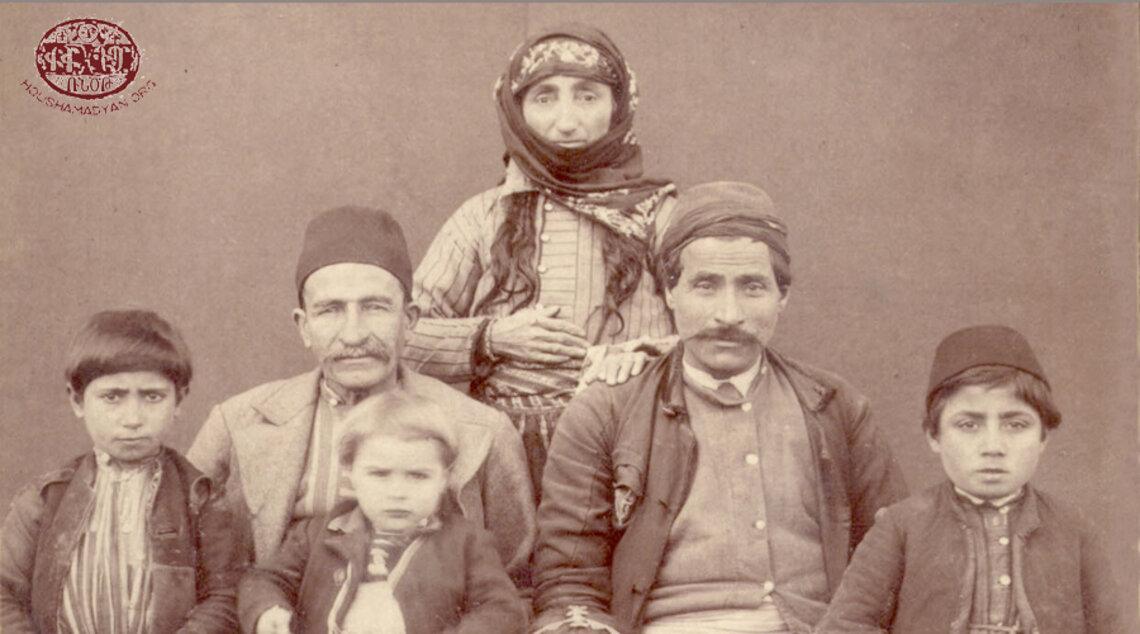
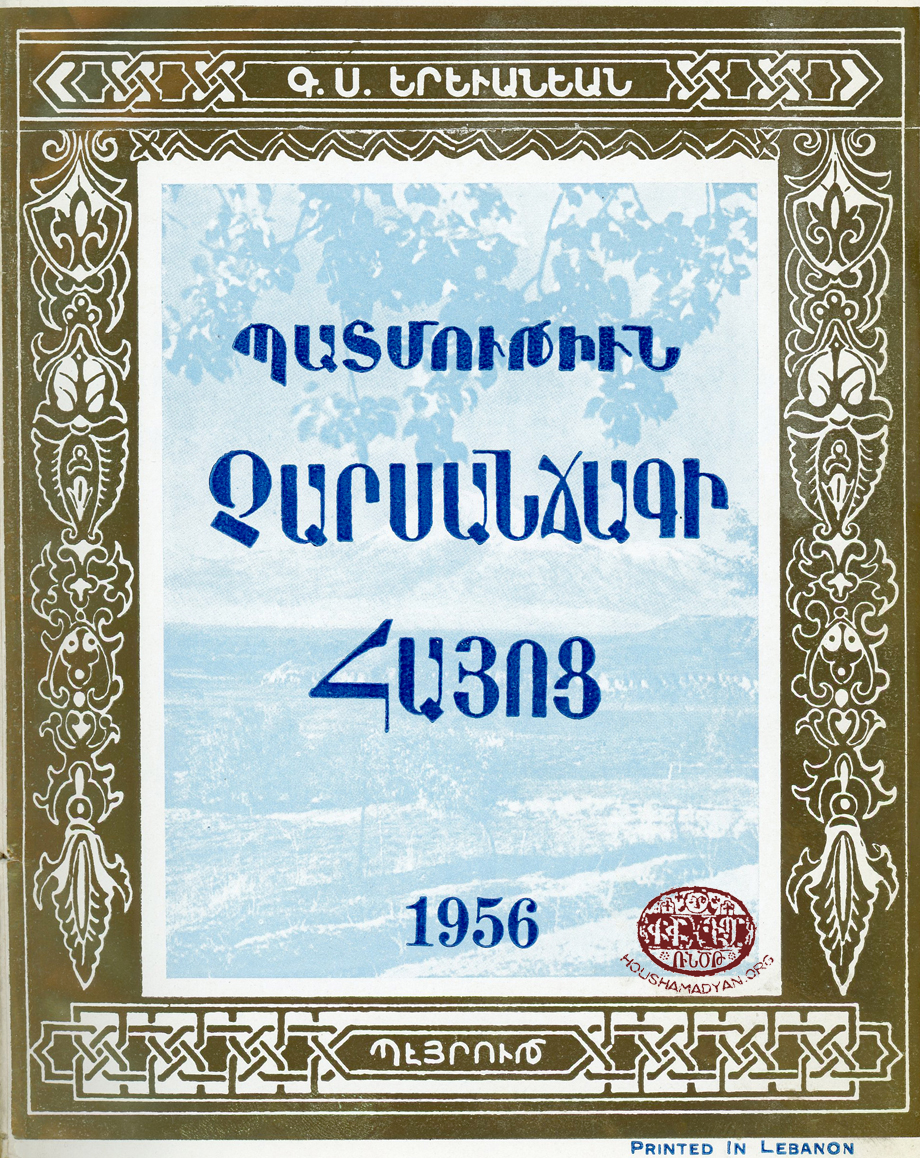
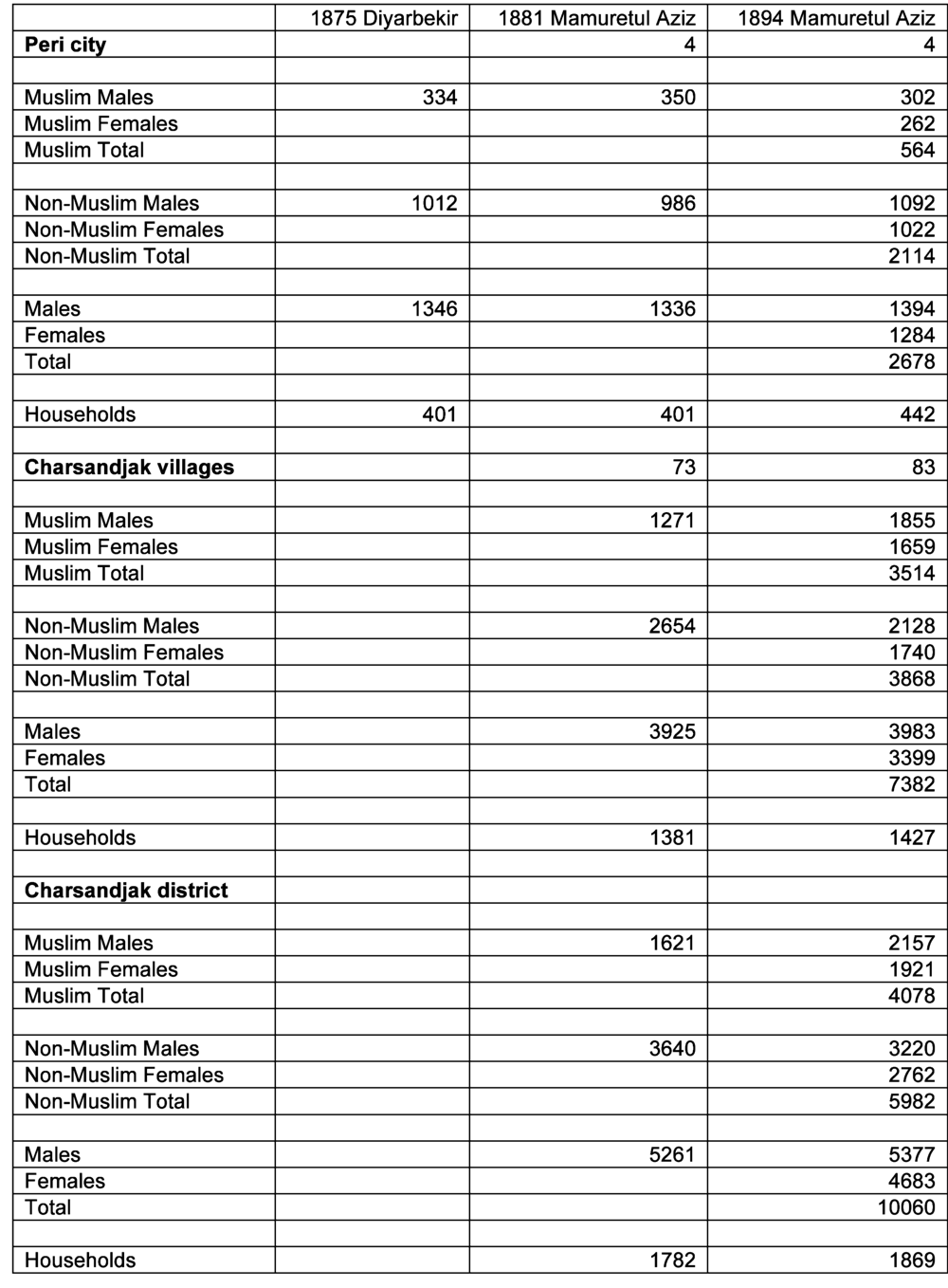
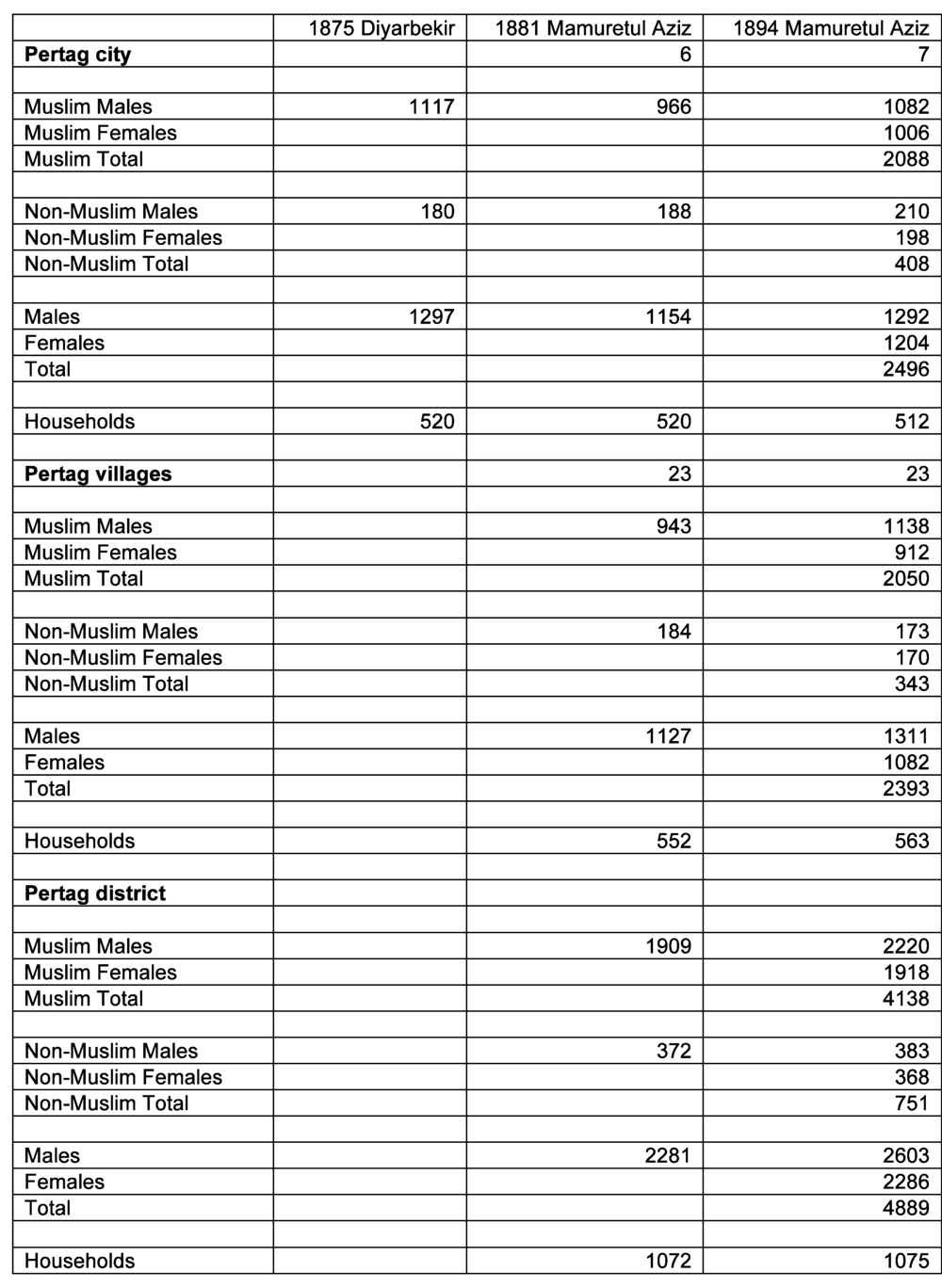
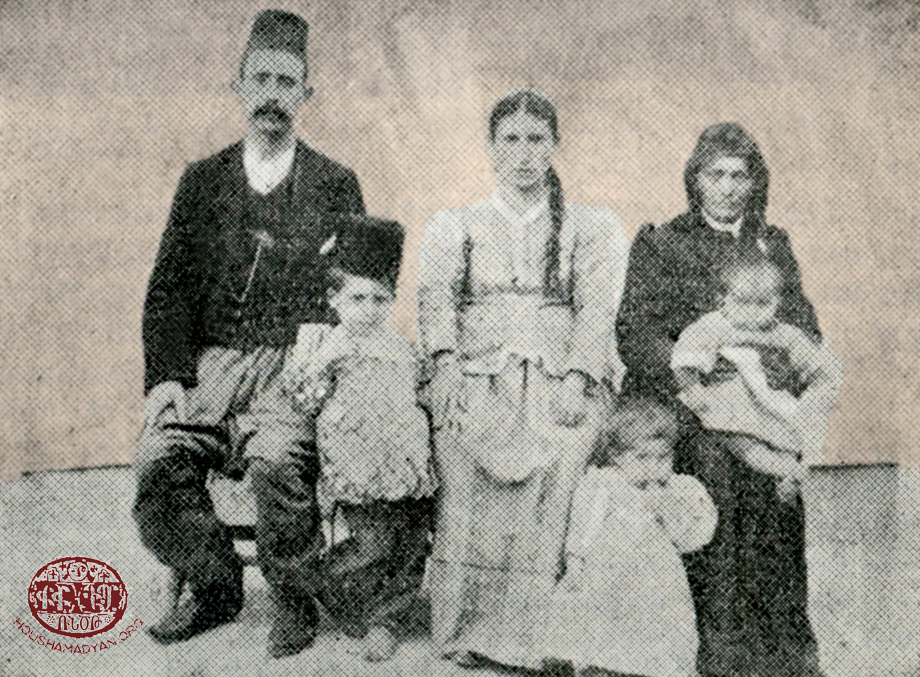
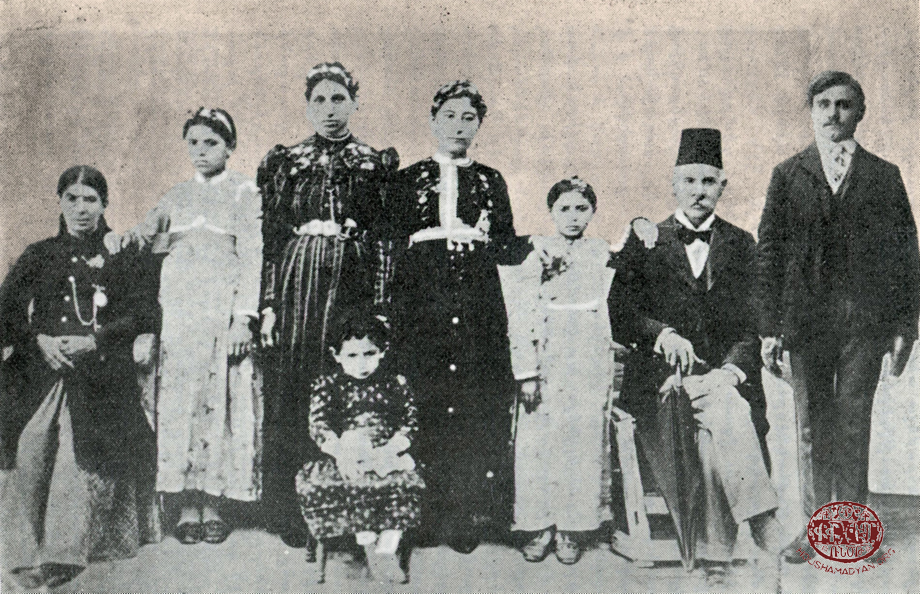
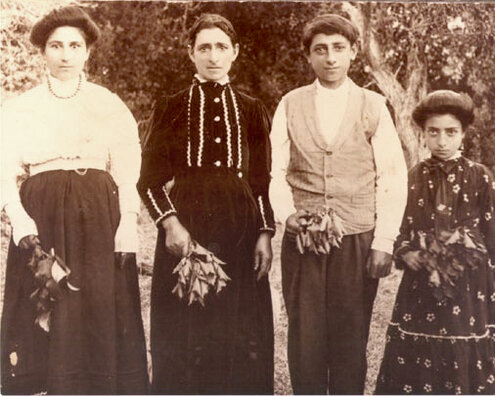
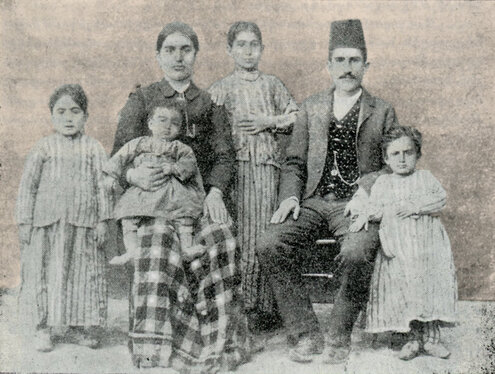
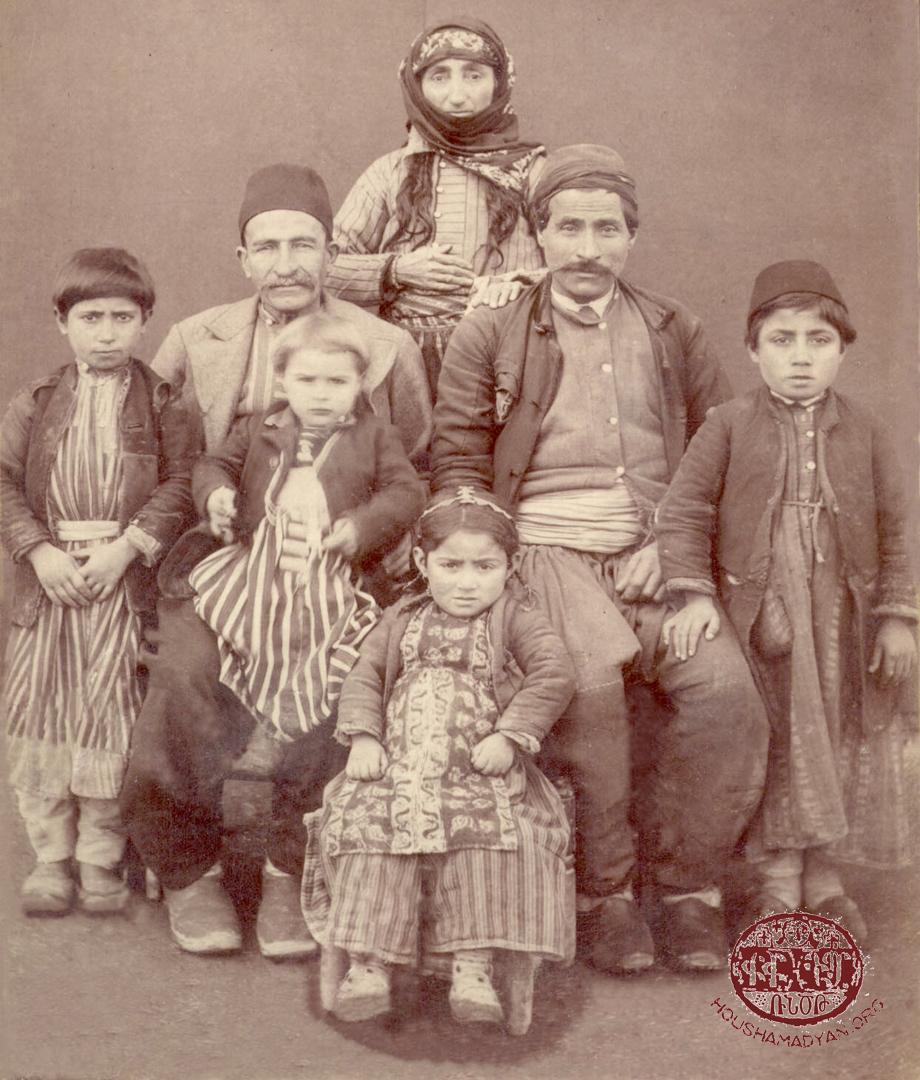
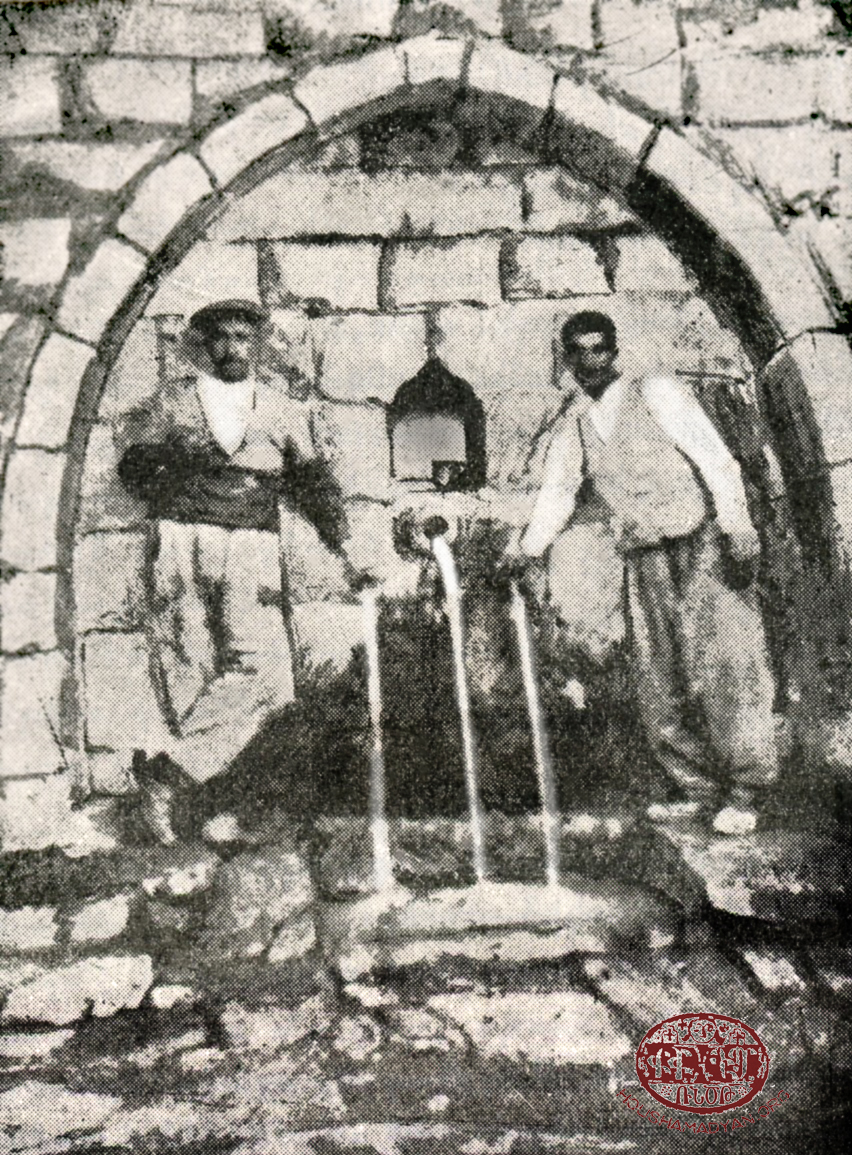
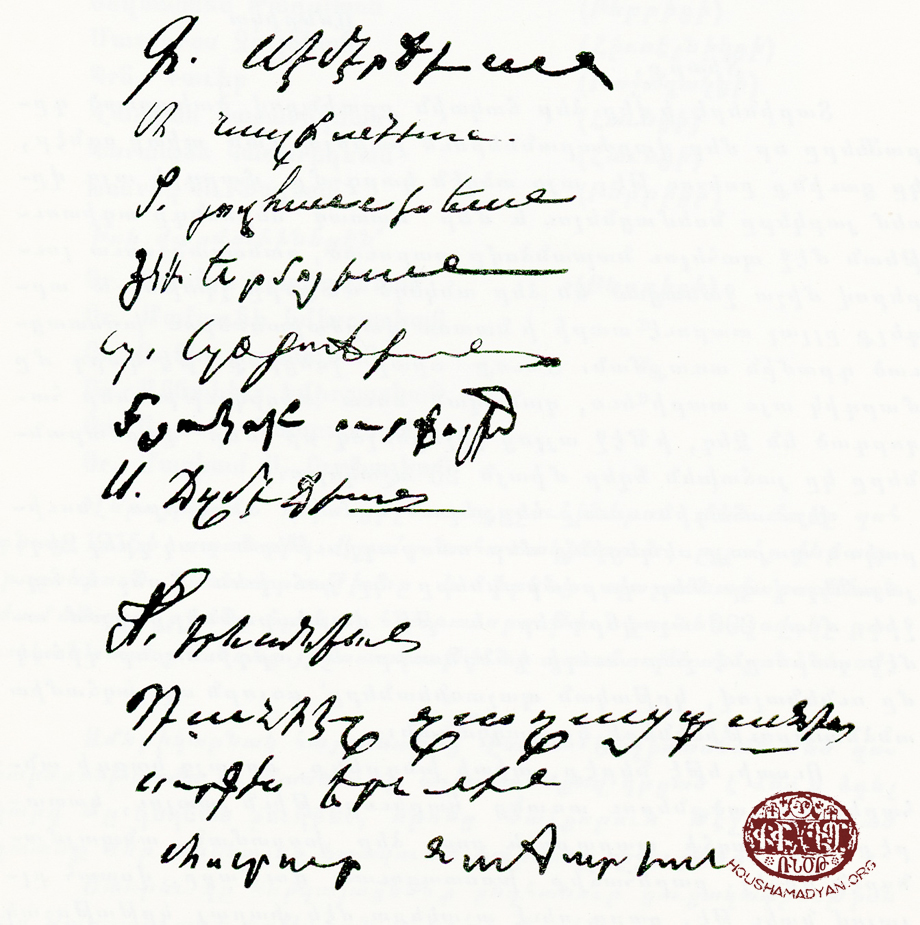
![Pertag [Pertek] Pertag [Pertek]](https://www.houshamadyan.org/fileadmin/_migrated/pics/Harput_SandjakDersim_Pertag_Vannutelli_1_web.jpg)
